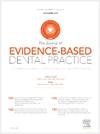LONG-TERM PREDICTIVE VALUE OF BLEEDING ON PROBING IN PERI‑IMPLANTITIS DIAGNOSIS: A SYSTEMATIC REVIEW AND META-ANALYSIS
IF 4
4区 医学
Q1 DENTISTRY, ORAL SURGERY & MEDICINE
引用次数: 0
Abstract
Objective
This systematic review and meta-analysis aimed to evaluate the diagnostic value of bleeding on probing (BOP) for peri‑implantitis detection on implant- and patient-levels, as reported in prospective and retrospective studies with at least 5 years of follow-up.
Materials and Methods
A systematic search of 3 electronic databases was conducted and supplemented with a hand-search to identify clinical studies that reported the prevalence of peri‑implantitis and BOP after at least 5 years of functional loading. Random-effects meta-analyses were conducted to combine the proportions of peri‑implantitis among BOP positive implants and patients across studies. Heterogeneity was explored with subgroup analyses.
Results
5826 patients and 17,198 implants were included in this review. Definitions of peri‑implantitis varied between studies. Thirty studies were included for assessment. Implant-level meta-analysis was conducted in 24 studies and patient-level meta-analysis in 19 studies. Overall proportion of peri‑implantitis in BOP-positive implants was 26.5% (95% CI, 21.2 to 32.1) and 35.1% (95% CI, 27.4 to 43.1) in BOP-positive patients. Substantial heterogeneity was present, and prediction intervals were 5.2%-56% and 6.4%-71.5% at the implant- and patient-level, respectively.
Conclusion
Within the limitations, prevalence of peri‑implantitis was found to be around 1 third in both BOP-positive implants and patients. Prevalence varied between studies. Although a guiding clinical factor in the diagnosis of peri‑implantitis, clinicians should be aware of the significant false-positive rates of BOP.
探诊出血在种植体周围炎诊断中的长期预测价值:系统回顾和荟萃分析
材料和方法对 3 个电子数据库进行了系统性检索,并辅以人工检索,以确定报告了至少 5 年功能负荷后种植体周围炎和 BOP 患病率的临床研究。研究人员进行了随机效应荟萃分析,将 BOP 阳性种植体和患者中种植体周围炎的比例结合在一起。通过亚组分析探讨了异质性。不同研究对种植体周围炎的定义各不相同。共纳入 30 项研究进行评估。对 24 项研究进行了种植体层面的荟萃分析,对 19 项研究进行了患者层面的荟萃分析。BOP阳性种植体发生种植体周围炎的总体比例为26.5%(95% CI,21.2-32.1),BOP阳性患者发生种植体周围炎的总体比例为35.1%(95% CI,27.4-43.1)。在种植体和患者层面上,预测区间分别为5.2%-56%和6.4%-71.5%。结论在局限性研究中发现,BOP阳性种植体和患者的种植体周围炎发病率约为三分之一。不同研究的发病率各不相同。虽然 BOP 是诊断种植体周围炎的一个临床指导因素,但临床医生应该意识到 BOP 的假阳性率很高。
本文章由计算机程序翻译,如有差异,请以英文原文为准。
求助全文
约1分钟内获得全文
求助全文
来源期刊

Journal of Evidence-Based Dental Practice
DENTISTRY, ORAL SURGERY & MEDICINE-
CiteScore
6.00
自引率
16.70%
发文量
105
审稿时长
28 days
期刊介绍:
The Journal of Evidence-Based Dental Practice presents timely original articles, as well as reviews of articles on the results and outcomes of clinical procedures and treatment. The Journal advocates the use or rejection of a procedure based on solid, clinical evidence found in literature. The Journal''s dynamic operating principles are explicitness in process and objectives, publication of the highest-quality reviews and original articles, and an emphasis on objectivity.
 求助内容:
求助内容: 应助结果提醒方式:
应助结果提醒方式:


